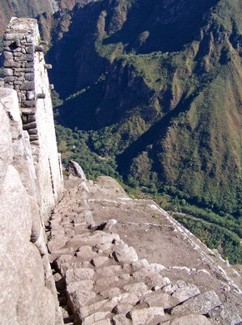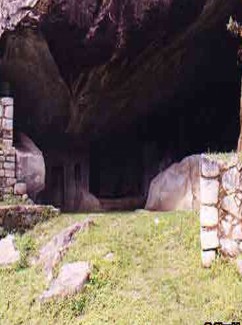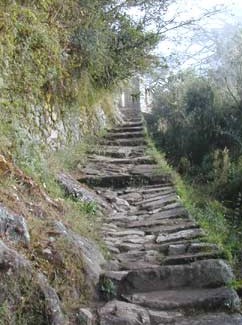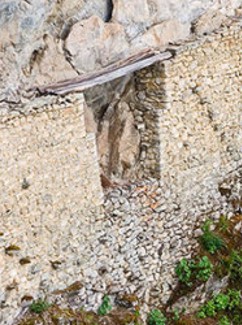|
SURROUNDINGS
Machu Picchu is surrounded by some archaeological sites, where it is
possible in short walkways some of the highly recommended to visit
are the Intipuncu, the "Templo de la Luna" (Moon Temple) and the
"Puente Levadizo"
(Drawbridge)
HUAYNA
PICCHU
Huayna Picchu is the pinnacle to the south of Machu Picchu, the
famous archaeological site in Peru, visible in the background of the
traditional postcard view of Machu Picchu. "Machu Picchu" means "Old
Mountain" or "Old Peak" in the local dialect, while "Huayna Picchu"
is "New" or "Young Peak".
The overnight in town allowes an early start the second morning,
avoiding the hordes of tourists who invade after the late-morning
arrival of the daily train from the city of Cuzco. Taking the 6:30
a.m. bus from Aguas Calientes allows starting the climb up Huayna
Picchu at the 7:00 a.m.
opening of the trail. Jaime, our tour guide, played up the
difficulty of the climb and encouraged extreme caution, stating that
it was done purely at the individual's choosing and responsibility.
Not a technically challenging climb, by any means, but well worth
the effort both for the views back to Machu Picchu and down to the
Urubamba river as it makes a U-turn around the base of Huayna Picchu.
THE
MOON TEMPLE
The Temple covers the entire landscape of the slopes of Huayna
Picchu and consists of a set of architecturally enhanced caves, most
likely used to hold mummies of important Inca ancestors and provide
places for their worship. More fine stonework embellishes the walls
of these caves, some of which are decorated with niches and altars
carved into the native rock.
INTIPUNCU
OR GATE OF THE SUN
Following the path leading to Machu Picchu to the south-east,
approximately 1 ½ miles away, tourists can reach the so called Inti
Punku (Sun-gate) from where we will have the most amazing picture of
Machu picchu. The Inti Punku is an important archeaological site
that was originally a fortress of the sacred city, reached through
the still-accessible "inti ñan" or "royal path". It is interesting
to note the presence of altars or resting stones, which could have
had a liturgical purpose, since Bingham called the facades, which
were built at intervals, "ritual stations".
THE
DRAWBRIDGE
This bridge is located about 30 minutes from Machu Picchu on a
narrow path through the jungle. It served as a defense on one of the
few entrances to the city This singular drawbridge is part of one of
the most dangerous trails in the city. The trail begins in the "Building
with Ten Windows" to the south of the citadel. It is a narrow path
daringly located on the flanks of a granite mountain. The 1 ½ mile
pathway is abruptly interrupted after a hairpin bend, giving way to
a precipice, spanned by a narrow drawbridge made of logs. Thus, the
logs are easily removable in case of danger. The bridge and the path
were built taking proper safety measures into account
|

Huayna Picchu

The
Moon Temple

Intipunku

The DrawBridge |
